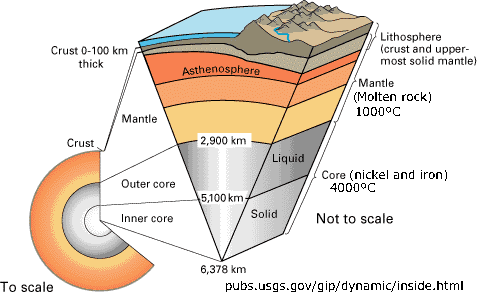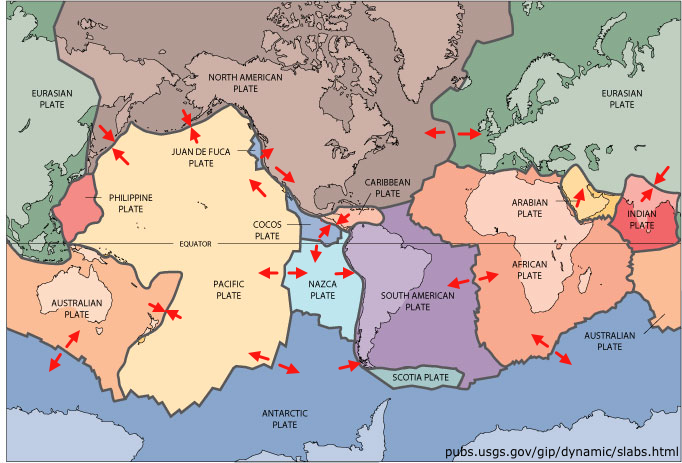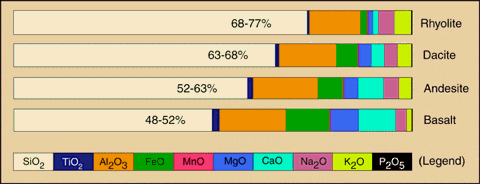Don's Home
 Science
Science
 Earth Science
Contact
Earth Science
Contact
|
Under Construction 
Earth Cross Section | Rocks | Rock Cycle | Minerals | Rare Earth Elements | Soil | Plate Tectonics | Satelites-ISS | Glossary Earth science (also known as geoscience) is an term used for multiple disciplines including Geology, Mineralogy, Geophysics, Oceanography, Atmospheric sciences, Biology and many sub-disciplines. Earth Cross Section:  The inner core is under such extreme pressure that it remains solid.
The inner core is under such extreme pressure that it remains solid.As the Earth rotates, the liquid outer core spins, creating the Earth's magnetic field. Most of the Earth's mass is in the mantle, which is composed of iron (Fe), magnesium (Mg), aluminum (Al), silicon (Si), and oxygen (O) silicate compounds. The mantle is solid but can deform slowly in a plastic manner. Convection in the mantle drives plate tectonic motions of the sea floor and continents. The upper part of the mantle and the crust form a rigid layer of rock called the lithosphere, is which broken up into the moving plates that contain the world's continents and oceans. See: Earth's Interior at UNR | |||||||||||||||||||||||||||||||||||||||||||||||||||||||||||||||||||||||||||||||||||||||||||
|
Rocks: Rocks are hard objects composed of single mineral or more typically a aggregate of minerals. See Minerals below. They are classified based on how they are formed.
Rocks are recycled from one type to another by forces such as plate tectonics and weathering.  Classification of volcanic rocks is by the proportion of light and dark minerals.
Types of volcanic rock:
Density:
Minerals: Except for native elements, minerals are salts composed of positively charged cations (e.g. K+, Na+, Ca++, Fe+++) and negatively charged anionic groups (e.g. CO3, PO4). Feldspars (KAlSi3O8 - NaAlSi3O8 - CaAl2Si2O8)is the most abundant mineral. Quartz (SiO2) is second. Single element minerals: Copper, Graphite (Carbon), Diamond (Carbon), Sulphur, Silver and Gold.
See: Rare Earth Elements: Modern technology (smart phones, laptops, batteries in hybrid vehicles and cordless tools, night vision goggles) all use rare earth elements. They're actually metals, and they aren't really rare; they're just scattered. 97% come from Chine, but in 2011 Japan discover them under the Pacific near Hawaii.
Examples: Soil: An average soil sample is 45 percent minerals, 25 percent water, 25 percent air, and five percent organic matter. Different-sized mineral particles from eroding rocks, such as sand, silt, and clay, give soil its texture. Fungi and bacteria help break down organic matter in the soil. Natural processes can take more than 500 years to form one inch of topsoil.
See: Plate Tectonics:   As plates collide one plate tends to move under the other and the friction causes for formation of magma causing volcanoes. Scientist are still debating whether the magma is generated by the partial melting of the subducted oceanic slab, or the overlying continental lithosphere, or both?
As plates collide one plate tends to move under the other and the friction causes for formation of magma causing volcanoes. Scientist are still debating whether the magma is generated by the partial melting of the subducted oceanic slab, or the overlying continental lithosphere, or both? As plates move side by side as the Pacific plate moving north and the North American plate moving south you get earthquakes.
See:
Distance to the horizon: D(km)=3.57√h(m) Glossary of Terms: Alpine Lake - lakes or reservoirs at high altitudes, usually starting around 5,000 feet
Brook: A small natural stream of fresh water smaller than a creek. 1
Clay: Composed primarily of fine-grained minerals. A subtype of phyllosilicate minerals composed of Aluminum (Al) Silicone (Si) and Oxygen (O) and other minerals. Clays have smaller particles < 2 µm. Clay Soil: a soil containing more than 40% clay, but less than 45% sand, and less than 40% silt. Creek: A small bending or winding stream that is often shallow or intermittent; a rivulet. Smaller than a stream larger than a brook.1 Estuary: the area where the fresh water of a river meets and mixes with the salt water of the ocean. Glacial Lake - a lake with origins in a melted glacier. Hill:
Lake: The definition is subjective.
1. Most of its area is too deep (> 6 ft) for plants to grow on the bottom. Loam: Soil composed of sand, silt, and clay in relatively even concentration (about 40-40-20% concentration respectively).
Mountain: A large landform that stretches above the surrounding land in a limited area usually in the form of a peak. A mountain is generally steeper than a hill. There is no universally accepted definition of a mountain. Various definitions have been proposed with heights from 300 m (984 ft) to 2,500 m (8,202 ft). Ocean: A major body of saline water. Oceans cover approximately 71% of the earth's surface. Pacific, Southern (extension of Pacific), Atlantic, Indian, and Arctic.
Pond: The distinction between a pond and lake is subjective. Reservoir: An artificial (man made by the construction of a dam) lake that is used to store water. River: A fairly large, moving body of fresh or brackish water that travels within a channel. I couldn't find any official definition distinguishing a stream from a river.1 Sand: Soil particles between 0.05 and 2 mm in diameter. Silt: A granular material of a size somewhere between sand and clay derived from soil or rock. Silt may occur as a soil or as suspended sediment in water. Stream: Organically shaped channel, moving water from one location to another following a defined shape in a natural or artificially altered environment; small river; a steady flow of water.1 Talus: A sloping mass of rocky fragments at the base of a cliff. Tributary: A stream or river that flows into a larger stream or river. Vernal Pool: Seasonal depressional wetlands that occur under the Mediterranean climate conditions of the West Coast. They are covered by shallow water for variable periods from winter to spring, but may be completely dry for most of the summer and fall. Watershed: The land area that drains water to a particular stream, river, or lake. It is a land feature that can be identified by tracing a line along the highest elevations between two areas on a map, often a ridge. Large watersheds, like the Mississippi River basin contain thousands of smaller watersheds.
1. I couldn't find any official definitions of streams. Stream is sometimes used as a generic term to cover anything from a brook to a river. Other times they are defined by size with no official flow rate or other measurement. By size they go from brook to creek to stream to river.
Other Glossaries:
Links: Earth History Extinctions Earthquakes | Volcanoes Tahoe geology Mountain Ranges Geological Time in History Atmospheric science (Climatology, meteorology) Water Science: Oceanography & Hydrology (limnology) Soil science (Biogeochemistry)Rocks and the Rock Cycle at ScienceViews.com USGS Photo Glossary of volcanic terms Granite Information Earth Sciences and News at Earth Pages Water Science: Oceanography & Hydrology Scholarly Societies EPA Western Ecology Division Cross section: Rock cycle, how rocks and minerals are formed, MineralTown.com The University of the State of NY - Regents High School Examination - Earth Science (https://www.nysedregents.org/EarthScience/113/esci12013-exam.pdf) Answers Climate Change / Global Warming
| |||||||||||||||||||||||||||||||||||||||||||||||||||||||||||||||||||||||||||||||||||||||||||
